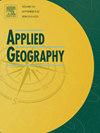Association between multidimensional poverty and urban spatial network design: Comparison between theory-driven and data-driven lenses
IF 4
2区 地球科学
Q1 GEOGRAPHY
引用次数: 0
Abstract
Poverty is increasingly identified as an urban phenomenon despite the promise that urban areas hold as the centres of economic and social progress. There is a need for knowledge on how the spatial network design, a signature of urban areas, is associated with poverty. This paper addresses this need by combining conventional theory-driven and emerging data-driven methods. We computed a multidimensional poverty index -MPI using geocoded household survey data in Kenya, which was treated as the dependent variable (target). The spatial Design Network Analysis (DNA) plug-in in ArcGIS Pro was used to quantify metrics of the spatial network design from a road network dataset of the study area, which was treated as the independent variables (features). We used the capability approach to provide a theoretical basis linking the social and physical network attributes. We then applied logistic regression and a machine learning algorithm, XGBoost, to analyse the network predictors of multidimensional poverty while controlling for confounders. The results of the logistic regression suggested that network density had the largest magnitude of margins (−1.004), which is significant at (p < 0.01) and negatively associated with multidimensional poverty. In contrast, results from the XGBoost algorithm suggested that network efficiency was the most important feature of the road network, with an impact of 16 percentage points. Severance and betweenness were among the top five important features of the network in both logistic regression and XGBoost. The situation of a household in either a formal or informal settlement was the most important confounder in both models. The results suggest that theory-driven logistic regression outperforms the machine learning algorithm based on our data and method. The logistic regression had an AUC of 0.794 compared to 0.692 in XGBoost. Our paper contributes to the knowledge about the association between spatial network design and multidimensional poverty, which helps improve our hypothesis and informs our theory. In addition, the results reveal the spatial design features that planners and policymakers should pay attention to in urban areas. We propose further research considering spatial heterogeneity and spatial dependence in the analysis.
多维贫困与城市空间网络设计的关系:理论驱动与数据驱动视角的比较
尽管城市地区有望成为经济和社会进步的中心,但贫穷日益被认为是一种城市现象。我们需要了解作为城市标志的空间网络设计是如何与贫困联系在一起的。本文通过结合传统的理论驱动和新兴的数据驱动方法来解决这一需求。我们使用肯尼亚地理编码的家庭调查数据计算了多维贫困指数-MPI,将其视为因变量(目标)。利用ArcGIS Pro中的空间设计网络分析(spatial Design Network Analysis, DNA)插件,对研究区道路网络数据集的空间网络设计指标进行量化,并将其作为自变量(特征)处理。我们利用能力方法为社会网络属性和物理网络属性之间的联系提供了理论依据。然后,我们应用逻辑回归和机器学习算法XGBoost来分析多维贫困的网络预测因子,同时控制混杂因素。逻辑回归结果表明,网络密度的边际值最大(- 1.004),在(p <;0.01),与多维贫困呈负相关。相比之下,XGBoost算法的结果表明,网络效率是道路网络最重要的特征,其影响为16个百分点。在逻辑回归和XGBoost中,网络的前五大重要特征是遣散性和中间性。在这两个模型中,一个家庭在正式或非正式定居地的情况是最重要的混杂因素。结果表明,基于我们的数据和方法,理论驱动的逻辑回归优于机器学习算法。逻辑回归的AUC为0.794,而XGBoost的AUC为0.692。我们的研究有助于了解空间网络设计与多维贫困之间的关系,这有助于完善我们的假设并为我们的理论提供信息。此外,研究结果还揭示了城市规划者和决策者应注意的空间设计特征。我们建议在分析中进一步考虑空间异质性和空间依赖性。
本文章由计算机程序翻译,如有差异,请以英文原文为准。
求助全文
约1分钟内获得全文
求助全文
来源期刊

Applied Geography
GEOGRAPHY-
CiteScore
8.00
自引率
2.00%
发文量
134
期刊介绍:
Applied Geography is a journal devoted to the publication of research which utilizes geographic approaches (human, physical, nature-society and GIScience) to resolve human problems that have a spatial dimension. These problems may be related to the assessment, management and allocation of the world physical and/or human resources. The underlying rationale of the journal is that only through a clear understanding of the relevant societal, physical, and coupled natural-humans systems can we resolve such problems. Papers are invited on any theme involving the application of geographical theory and methodology in the resolution of human problems.
 求助内容:
求助内容: 应助结果提醒方式:
应助结果提醒方式:


